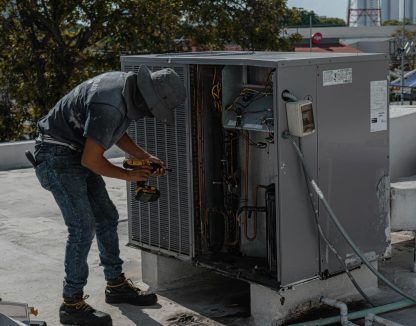As the backbone of comfortable living and working spaces, Heating, Ventilation, and Air Conditioning (HVAC) systems play a crucial role in maintaining optimal indoor environments. For HVAC technicians, having the right set of tools is not just a matter of convenience; it’s a necessity for ensuring efficient installations, precise diagnostics, and reliable repairs. In this comprehensive guide, we’ll explore the essential HVAC tools that every technician should have in their arsenal, categorized for different functions and applications.
Ready to Learn More?
Essential Hand Tools
1. Screwdrivers
Screwdrivers are the workhorses of any technician’s toolkit. A diverse range of HVAC systems means encountering an assortment of fasteners. Having both flathead and Phillips screwdrivers in various sizes ensures that technicians are prepared for any task. Whether it’s securing panels, adjusting thermostat settings, or handling electrical components, having the right screwdriver can make the job smoother.
2. Pliers
Pliers come in handy for gripping, bending, and manipulating small components and wires. Needle-nose pliers provide precision in tight spaces, while regular pliers offer a strong grip for various tasks. Wire stripping pliers also enables technicians to create secure electrical connections. From securing electrical connections to adjusting components, pliers are indispensable for HVAC technicians working with intricate systems.
3. Wrenches
The diversity of HVAC equipment often requires technicians to tighten or loosen nuts of different sizes. Adjustable and fixed wrenches, available in both standard and metric measurements, are essential tools for maintaining HVAC systems. Technicians must be equipped with a range of pipe wrenches to handle the various components they may encounter during installations and repairs.
4. Tape Measure
Accurate measurements are the foundation of successful HVAC work. Whether installing new systems, replacing components, or ensuring proper clearances, a durable and easy-to-read tape measure is a technician’s best friend. Precision in measurements not only ensures a seamless fit but also contributes to the overall efficiency and longevity of HVAC systems.
5. Extension Cords
HVAC techs often need extension cords to plug in electric tools when working onsite. Look for a long, thick cord that’s not too bulky to transport. A safe bet is a 50ft extension cord.
6. Staple Gun
Keep a staple gun on your HVAC tools list to secure joists and foil lines for increased air flow, and to properly assemble ductwork.
7. Duct Knife
Use a duct knife to cut ductwork or fiberglass insulation for HVAC installs.
Diagnostic Tools
8. Multimeter
HVAC systems involve intricate electrical components, and a multimeter is indispensable for diagnosing electrical issues. Technicians use multimeters to measure voltage, current, and resistance, providing crucial insights into the health of the system. Whether identifying faulty wiring or assessing the performance of electrical components, a reliable multimeter is a must-have tool in the HVAC technician’s toolkit.
9. HVAC Gauges
Maintaining optimal refrigerant levels is critical for the efficiency of HVAC systems. HVAC gauges, including pressure and refrigeration gauges, allow technicians to measure and adjust refrigerant levels accurately. These gauges provide insights into the system’s pressure, aiding in the diagnosis of potential issues. Proper refrigerant levels not only ensure efficiency but also contribute to the longevity of the HVAC system.
10. Thermometer
Temperature control is at the heart of HVAC systems, making a thermometer an essential diagnostic tool. Digital or infrared thermometers enable technicians to measure temperatures accurately. Whether assessing air ducts, checking the output of vents, or troubleshooting heating and cooling issues, a reliable thermometer is vital for maintaining optimal climate control.
Power Tools
11. Cordless Power Drill
Efficiency is key in HVAC installations and repairs, and a power drill is a versatile tool that enhances productivity. From drilling holes for fasteners to driving screws into various materials, a power drill is a time-saving asset for technicians. Corded and cordless options offer flexibility based on the specific requirements of the job.
12. Reciprocating Saw
For cutting through a variety of materials, including metal and plastic, a reciprocating saw is a go-to power tool for HVAC technicians. Whether trimming ductwork or removing sections of material, this tool provides precision and speed. Safety precautions, including the use of appropriate blades and personal protective equipment, are crucial when operating a reciprocating saw.
13. Heat Gun
Soldering and shaping materials are common tasks in HVAC work, and a heat gun is the tool of choice for these applications. Whether bending plastic components or sealing connections, a heat gun provides the controlled application of heat. Technicians should exercise caution and follow safety guidelines when using a heat gun to prevent accidents and ensure accurate results.
Refrigeration Tools
14. Refrigerant Recovery Machine
With environmental concerns and regulations in mind, a refrigerant recovery machine is an essential tool for HVAC technicians. During system maintenance or decommissioning, technicians use these machines to safely remove refrigerants, preventing environmental harm and ensuring compliance with industry standards. Proper refrigerant recovery contributes to sustainability and responsible HVAC practices.
15. Vacuum Pump
Maintaining the efficiency of HVAC systems requires removing air and moisture from the refrigeration circuit. A vacuum pump is the tool of choice for achieving this, ensuring a reliable and airtight system. Technicians use vacuum pumps during installations and maintenance to create the necessary vacuum, promoting optimal performance and preventing issues such as frost formation and compressor damage.
Specialty Tools
16. Tube Cutter
Precision is paramount when working with copper tubing in HVAC systems. A tube cutter provides clean and accurate cuts, ensuring that tubing fits seamlessly into connectors. Whether installing new lines or replacing components, a tube cutter is a specialized tool that contributes to the overall integrity and efficiency of the HVAC system.
17. Flaring Tool
Creating flares on tubing ends is a common requirement in HVAC work, especially when dealing with refrigeration systems. A flaring tool ensures a secure and leak-free connection between tubing and fittings. Properly flared connections are critical for preventing refrigerant leaks, which can compromise system efficiency and pose environmental risks.
18. Multimeter
When working near electrical hazards and live wires, it’s important to test for safety. Keep a multimeter in your toolbox to test for the presence of electricity and to check voltage.
19. Nitrogen Regulator Gauges
Keep these gauges handy for when you need to check and regulate the flow of nitrogen gas in an HVAC system.
20. Thermal Imaging Tools
HVAC technicians need to diagnose complex problems for clients based on very general information. Thermal imaging cameras, enable techs to accurately identify and fix the root causes quickly.
21. Coil Fin Straighteners
A coil fin straightener helps to clear debris when air conditioner condenser coils get dirty, clogged, or twisted. Service techs use this air conditioning tool to straighten and clean the coils to improve heat exchange and airflow.
22. Fin Whisk
A fin whisk makes cleaning dust and dirt from wall condenser and evaporator coils easy, without causing damage to the fins.
23. Refrigerator Coil Brush
Easily clean between coil and fan blade easily, removing build-up. A coil brush is ideal for cleaning refrigerator condensers and commercial refrigeration static coils.
Safety Gear
24. Safety Glasses
Protecting the eyes is a top priority in any technical field, and HVAC work is no exception. Safety glasses shield technicians from debris, dust, and potential hazards. Whether working with power tools, handling materials, or troubleshooting components, safety glasses are a fundamental component of personal protective equipment (PPE).
25. Work Gloves
The hands are often in the line of fire when it comes to HVAC work, making quality work gloves a necessity. From protecting against sharp edges during installations to providing insulation when handling hot components, the right pair of work gloves enhances safety and comfort for technicians. Different types of gloves may be required for tasks ranging from general handling to specialized applications.
26. Masks/PPE
Wearing masks while performing HVAC work provides personal protection for your techs as well as your customers. Now considered essential PPE, make sure your techs keep a stash of masks in their trucks to use on every job.
27. Ear Muffs/Plugs
Using power tools in close quarters can put a strain on your ears and impact your hearing. Protect your ears with industrial-strength ear muffs or ear plugs.
Tools to Manage HVAC Service Operations
28. HVAC Scheduling Software
With Payzer’s HVAC scheduling software, you can optimize your technicians’ schedules by assigning them to jobs based on their location, skill set, and availability. This means you can ensure that the right technician is sent to each job, saving time and reducing the need for unnecessary travel. By optimizing your technicians’ schedules, you can complete more jobs each day, ultimately increasing your profits. What could getting to 1 additional job per day mean for your bottom line? What about one job per day, per technician? Creating efficiencies using HVAC dispatch software with small changes throughout the day can help you achieve that without a heavy lift.
29. HVAC Software Mobile App & Tablet
Providing your technicians with software available on a mobile device increases the efficiency of each technician and your overall business. From the mobile app, they can easily navigate to the job, check-in, upload notes and photos, create proposals and invoices, and even collect payment on the job. Having this type of software at their disposal increases productivity.
30. Payzer’s Financing Calculator
Being able to offer financing on the job not only increases your overall close rate but also increases your customer satisfaction. Using Payzer’s financing calculator via the Payzerware web or mobile app, your technicians can offer an affordable plan on the spot. With approvals in less than one minute from multiple lenders, capture the sale immediately.
You can get started by signing up for Payzerware Payment Options today!
A well-equipped technician is a more efficient and safe technician. The diverse array of hand tools, diagnostic instruments, power tools, refrigeration tools, specialty equipment, and safety gear outlined in this guide forms the foundation of a comprehensive HVAC toolkit. Equipping your technicians with the right tools not only enhances their capabilities but also contributes to the longevity and reliability of HVAC systems. By prioritizing the proper tools for the job, HVAC professionals can navigate the complexities of their work with confidence and precision.







